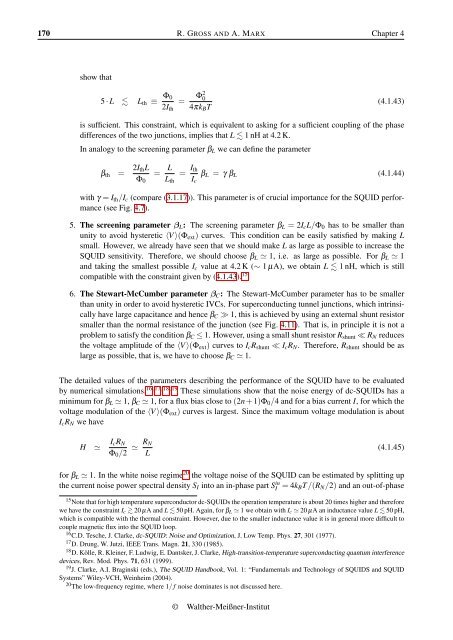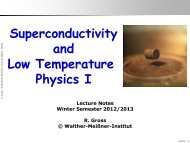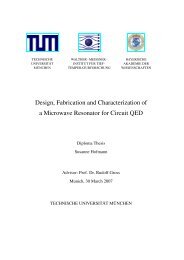Applied Superconductivity - Walther Meißner Institut - Bayerische ...
Applied Superconductivity - Walther Meißner Institut - Bayerische ...
Applied Superconductivity - Walther Meißner Institut - Bayerische ...
- No tags were found...
Create successful ePaper yourself
Turn your PDF publications into a flip-book with our unique Google optimized e-Paper software.
170 R. GROSS AND A. MARX Chapter 4show that5 · L L th ≡ Φ 02I th= Φ2 04πk B T(4.1.43)is sufficient. This constraint, which is equivalent to asking for a sufficient coupling of the phasedifferences of the two junctions, implies that L 1 nH at 4.2 K.In analogy to the screening parameter β L we can define the parameterβ th = 2I thLΦ 0= LL th= I thI cβ L = γ β L (4.1.44)with γ = I th /I c (compare (3.1.17)). This parameter is of crucial importance for the SQUID performance(see Fig. 4.7).5. The screening parameter β L : The screening parameter β L = 2I c L/Φ 0 has to be smaller thanunity to avoid hysteretic 〈V 〉(Φ ext ) curves. This condition can be easily satisfied by making Lsmall. However, we already have seen that we should make L as large as possible to increase theSQUID sensitivity. Therefore, we should choose β L ≃ 1, i.e. as large as possible. For β L ≃ 1and taking the smallest possible I c value at 4.2 K (∼ 1 µA), we obtain L 1 nH, which is stillcompatible with the constraint given by (4.1.43). 156. The Stewart-McCumber parameter β C : The Stewart-McCumber parameter has to be smallerthan unity in order to avoid hysteretic IVCs. For superconducting tunnel junctions, which intrinsicallyhave large capacitance and hence β C ≫ 1, this is achieved by using an external shunt resistorsmaller than the normal resistance of the junction (see Fig. 4.11). That is, in principle it is not aproblem to satisfy the condition β C ≤ 1. However, using a small shunt resistor R shunt ≪ R N reducesthe voltage amplitude of the 〈V 〉(Φ ext ) curves to I c R shunt ≪ I c R N . Therefore, R shunt should be aslarge as possible, that is, we have to choose β C ≃ 1.The detailed values of the parameters describing the performance of the SQUID have to be evaluatedby numerical simulations. 16,17,18,19 These simulations show that the noise energy of dc-SQUIDs has aminimum for β L ≃ 1, β C ≃ 1, for a flux bias close to (2n + 1)Φ 0 /4 and for a bias current I, for which thevoltage modulation of the 〈V 〉(Φ ext ) curves is largest. Since the maximum voltage modulation is aboutI c R N we haveH ≃ I cR NΦ 0 /2 ≃ R NL(4.1.45)for β L ≃ 1. In the white noise regime 20 the voltage noise of the SQUID can be estimated by splitting upthe current noise power spectral density S I into an in-phase part SIin = 4k B T /(R N /2) and an out-of-phase15 Note that for high temperature superconductor dc-SQUIDs the operation temperature is about 20 times higher and thereforewe have the constraint I c 20 µA and L 50 pH. Again, for β L ≃ 1 we obtain with I c ≃ 20 µA an inductance value L 50 pH,which is compatible with the thermal constraint. However, due to the smaller inductance value it is in general more difficult tocouple magnetic flux into the SQUID loop.16 C.D. Tesche, J. Clarke, dc-SQUID: Noise and Optimization, J. Low Temp. Phys. 27, 301 (1977).17 D. Drung, W. Jutzi, IEEE Trans. Magn. 21, 330 (1985).18 D. Kölle, R. Kleiner, F. Ludwig, E. Dantsker, J. Clarke, High-transition-temperature superconducting quantum interferencedevices, Rev. Mod. Phys. 71, 631 (1999).19 J. Clarke, A.I. Braginski (eds.), The SQUID Handbook, Vol. 1: “Fundamentals and Technology of SQUIDS and SQUIDSystems” Wiley-VCH, Weinheim (2004).20 The low-frequency regime, where 1/ f noise dominates is not discussed here.© <strong>Walther</strong>-Meißner-<strong>Institut</strong>
















